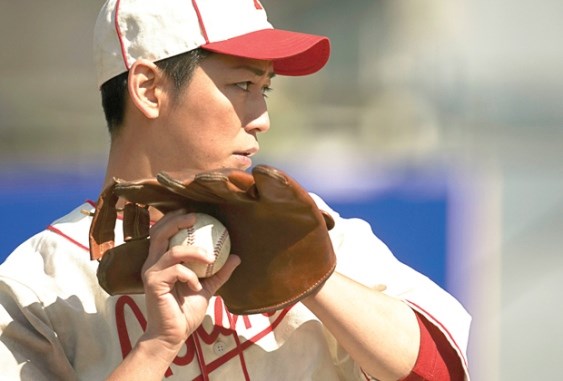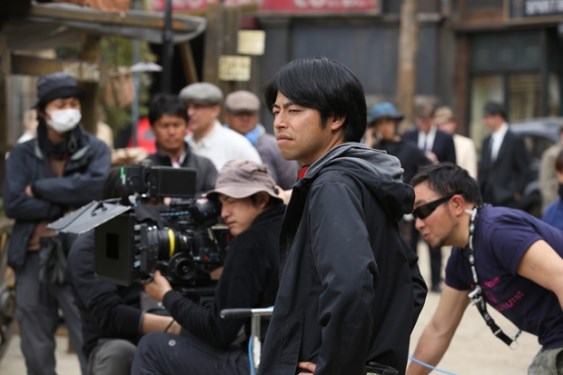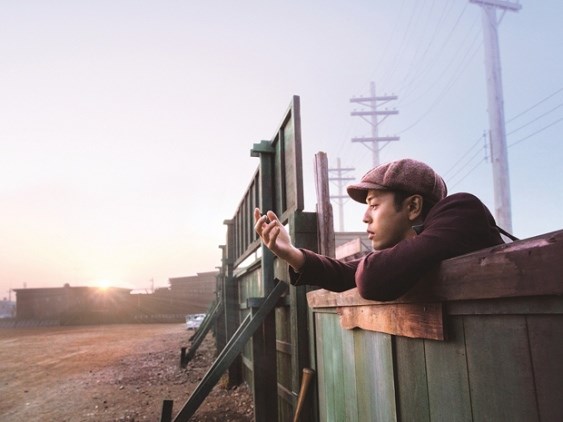Equal parts Warner Brothers melodrama and , Yuya Ishiiâs latest work, The Â鶹´«Ã½Ó³»Asahi, recreates Vancouverâs long-lost âJapantownâ on a studio set in Ashikaga, Tochigi Prefecture, north of Tokyo.
The fiction film, based in part on the real-life exploits of the legendary Asahi baseball team, receives its world premiere on Sept. 29 at the Centre for Performing Arts as part of this yearâs Â鶹´«Ã½Ó³»International Film Festival.
âI saw Â鶹´«Ã½Ó³»Asahi in Tokyo in not-quite finished form,â says Tony Rayns, the London-based East Asian film scholar and critic who programs VIFFâs Dragons and Tigers Asian film competition each year. âI went to the lab to see it. Because of the very obvious Â鶹´«Ã½Ó³»connection the company hoped there would be interest from the festival in premiering the film.
âThey thought it would be good for promotion in Japan because the film hasnât opened in Japan yet. They are bringing over quite a number of people. Two of the young stars who are very hot in Japan right now will be here and theyâre obviously going to have camera crews out in force. Theyâre going to be sending this footage back to Japan where it will serve as part of the promotional push in Japan for the release there.â
Up until the Asahi (made up of second generation Japanese/Canadians) formed in 1914, all baseball teams with Japanese players in North America competed in racially-segregated leagues against other Japanese and non-white teams.
Originally started as a youth squad the Asahi played their home games at the Powell Street Grounds (now Oppenheimer Park). They added recruits from a pre-existing team called the Nippons and joined the Â鶹´«Ã½Ó³»City Senior Amateur Baseball league in 1919 to match forces against the likes of the Independent Longshoremenâs Association, Canadian Pacific Railway and Sprott-Shaw teams.
Over the years the Asahi (meaning âmorning sunâ) won many titles with a style of play called âbrain ball,â which focused on base running speed, bunts and defensive tactics to beat the bigger, stronger teams. They took four consecutive Terminal League Championships between 1930 and 1933 and five Pacific Northwest Championships from 1937-1941. In 1938 they claimed a triple-crown season as the top team in the Burrard, Commercial and Pacific Northwest Leagues.
Their Pacific Northwest Championship victory on Sept. 18, 1941 was the last game the Asahi played as a team. Two months later Canada was at war with Japan and all Japanese/Canadian citizens were branded as âenemy aliensâ and dispersed into internment camps, never to return to their pre-Second World War lives.
Driving by Oppenheimer Parkâs Tent City today itâs difficult to imagine the area was once home turf for the Asahi and a thriving Japanese community. The baseball team provided a cultural focus for the surrounding neighbourhood. Their success on the field, featuring homegrown second-generation/nisei talent such as shortstop Roy Yamamura and outfielder/base-stealer Tom Matoba, brought a sense of pride to the community and opened up lines of communication with the dominant culture.
Ishiiâs film draws viewers deep into the history of the Asahi and its cultural milieu with an old school approach to filmmaking. The microcosm that was Japantown is writ large on the big screen with a sense of purpose and artistic vision that brings everything to life.
Most of the area around Powell Street has changed considerably since the golden age of the Asahi. âI think they did check out Â鶹´«Ã½Ó³»and realized thereâs nothing left of â30s Vancouver,â says Rayns.Ìý âThereâs no location in Â鶹´«Ã½Ó³»that would pass for the 1930s without a huge amount of modification â and also it would not be very practical to shoot today on the Â鶹´«Ã½Ó³»waterfront. I donât think anybody would agree to close down their businesses for weeks so a film crew could move in. What they ended up doing was building a huge, outdoor set in Japan. Itâs in quite a rural place but itâs based meticulously on photos and drawings from the period which I saw. It was really quite impressive on a very big scale and the film was essentially shot there.âÌý Ìý
Several members of the Â鶹´«Ã½Ó³»Asahiâs young cast, such as Kazuya Kamenashi who plays ace pitcher Roi âRoyâ Naganishi, are big pop stars in Japan with established acting and music careers.

Everyone hired for the film was also expected to know their baseball. The script may take some poetic license with box scores and timelines but that's all part of the story arc.
âThey had to play baseball badly at least in the beginning,â says Rayns. âWe have to see their learning curve because as far as Iâm aware this is a completely faithful recreation of what actually happened. When the team started they were a disaster. They achieved absolutely nothing but they re-thought their strategy, they developed techniques and so on and they got better and then started to win games. The film has to reflect that. They have to play competent baseball and get better as the thing goes on.â
Ìý
Married to film actress Hikari Mitsushima (who began her career as a teen idol singer in the J-pop group Folder 5) the 30-year-old Ishii has immaculate pop culture credentials himself. Heâs had several of his films shown at VIFF over the years with the festival tracing his trajectory from an indie auteur to the more ambitious projects of an established filmmaker.

âHeâs one of the most in-demand filmmakers there is in Japan,â says Rayns. âHe came here for the first time seven years ago with his first feature which was actually his graduation film from film school. A film called Bare-assed Japan which is quite a modest indie feature â very small scale, small cast but very quirky, interesting, with unusual characters especially for a Japanese film where things tend to be rather conformist, I think itâs fair to say. His films were never at all conformist or they were rather critical about conformism. He stood out from the pack in some ways.
âWe showed his first film in competition, it didnât win as I recall, but it was well-received by the audience and he enjoyed his visit to Vancouver. We kept showing his films, not everything he made, but quite a lot. Three or four years ago we premiered what was his last big indie film, Mitsoko Delivers, as an awards night gala film. He came back to Â鶹´«Ã½Ó³»and that was in The Vogue as I remember. It went down extremely well with a packed house. Last year he wasnât here but we showed his first major commercial film The Great Passage which is sort of a star-led film about the unlikely subject of compiling a dictionary. It has big stars in it and he made something very fresh and surprising with it. Weâve followed his progress from a small indie filmmaker fresh out of film school through to making big budget films with big stars. Heâs in seriously big demand. This guy could make three films a year if he could find the time and the energy to do it because there are that many companies clamouring to have him make things for them.â
Last year he won best director at the Japan Academy Awards for The Great Passage and The Â鶹´«Ã½Ó³»Asahi pushes Ishiiâs filmmaking to another level entirely. âItâs old fashioned but in the best sense,â says Rayns. âThis is the kind of filmmaking that doesnât happen so much anymore in these days of CGI and monsters and superheroes and such. Itâs very beautifully done and with a modern spirit.â
Ishii and actors Satoshi Tsumabuki and Kazuya Kamenashi will be at the world premiere on Monday night.
For more information and a complete schedule of film screenings, visit .



